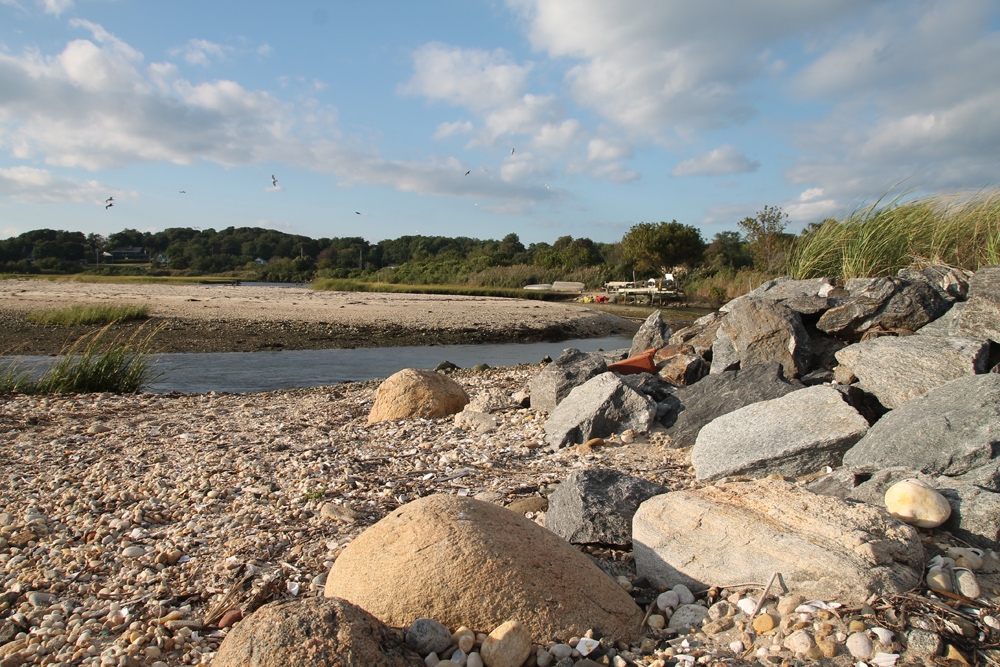Orient farmer to dredge Oysterponds Creek, freshen up water

The owner of an esteemed oyster farm in Orient received approval from the town to launch dredging at the mouth of the Oysterponds Creek in a project officials say will improve the quality of the creek’s ecosystem — including its shellfish.
At the Southold Board of Trustees meeting on Aug. 19, Suffolk Environmental Consulting requested a permit on behalf of Reg Tuthill and his South Dyer LLC to dredge 3,200 cubic yards of underwater sand at the mouth of the creek that connects the Oysterponds with the much-larger Orient Harbor to the south.
The Board of Trustees voted unanimously to grant the permit at that meeting in what Board President John Bredemeyer described as “one of the best projects [he has] ever seen for environmental maintenance.”
“We did not see a downside to this proposal,” Mr. Bredemeyer said. “This is a privately funded project with several public benefits.”
Mr. Tuthill did not return several requests for comment, but his application states the purpose of dredging is to “enhance tidal flushing in support of continuing oyster culture.”
In 2013, he told Bloomberg Businessweek that “the flow is the most important thing” in the oyster business.
For the project, a crane equipped with a clamshell bucket will scoop 3,200 cubic yards of sand and mud from the bottom of the water, allowing more water to flow through the channel. The sediment that is scooped up will be deposited on the beach facing the creek from the west, which is within the Tuthills’ property line.
Clearing that waterway will allow the entire pond — both the Tuthills’ oyster farm and beyond — to become cleaner.
Mr. Bredemeyer estimated the project will begin sometime next year, likely in late spring, and the permit also grants 10-year maintenance.
According to the application documents, all of the surrounding neighbors were mailed letters notifying them of the pending application. A public notice was posted before the Aug. 19 meeting, but Mr. Bredemeyer said no one spoke up in opposition.
“It doesn’t affect the character of the creek,” Mr. Bredemeyer said. “We’re not building this up for deep-water navigation. It’s basically to maintain the shellfish operation.”
The trustees own most of the Oysterponds to the northwest of Mr. Tuthill’s property, but the family has owned a chunk including the creek’s entryway since the 17th century.
Last year, South Dyer LLC proposed subdividing the parcel to include five residential lots on the east side of the land, with an additional 94 acres to be preserved. That proposal, while it met pushback from the community last winter, is still active in the town’s Planning Department. In July, the Planning Board issued a positive declaration on the subdivision, which will start a more formal environmental review of the plan.
The channel leading into the pond has not been dredged since 1968 or 1969, Mr. Bredemeyer said, so sediment has built up in the almost 50 years since. He likened the creek to “a person with an obstructed airway;” since the opening to the Oysterponds is somewhat blocked, water cannot flush in and out as freely, and dredging the bottom is the “equivalent of a Heimlich maneuver.”
John Holzapfel, who worked with Mr. Tuthill until his retirement last winter, said the best oysters come from areas that have both substantial food and substantial water movement.
“The more flushing, the healthier all of the waters will be,” he said. “The flushing of the creek will keep the waters nice and clean.”
In this creek, he said, the turnover time — the amount of time for the water to change completely — is only six hours, drastically lower than similar bodies of water. That helps make it so good for oyster farming.
Mr. Holzapfel pointed to a 2007 book, titled “A Geography of Oysters,” in which Rowan Jacobsen argues the Tuthills own the single-best plot for shellfishing in the area.
“Reg Tuthill has the good fortune to own, not lease, the prime piece of natural oyster real estate on the East Coast,” Mr. Jacobsen wrote in his book, which was excerpted for the fall 2008 issue of Edible East End.
Beyond the Tuthills, Mr. Bredemeyer said the project brings substantial benefits for the public. Most simply, it makes the entry to the creek deep enough for individual kayakers to pass through.
And while the Tuthills’ oysters will enjoy cleaner, less stagnant water, so too will all of the shellfish that live farther into the Oysterponds. That means any local enthusiasts can catch healthier clams and oysters in the publicly owned portion of the water.
There are benefits for the ecosystem outside of the water, too: Mr. Bredemeyer explained that some birds, especially piping plovers, can use the newly deposited sandbanks for nests. Moreover, mosquito numbers will decline since the water will be less stagnant and since more fish that eat mosquitoes can swim higher up the creek.
“There’s really no drawback that I can see,” he said.
Photo Caption: The entrance to Oysterponds Creek is set to be dredged, which should make the water cleaner and improve the shellfish inside. (Credit: Paul Squire)





